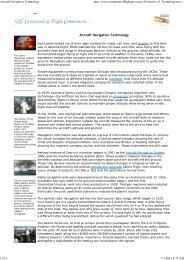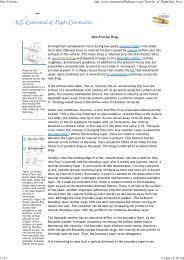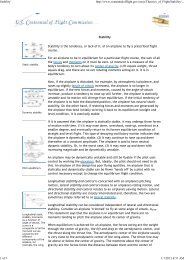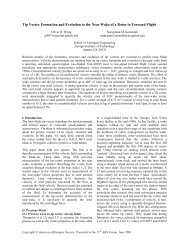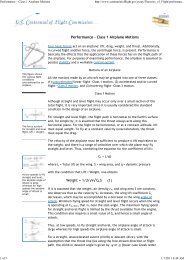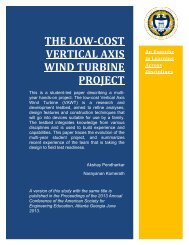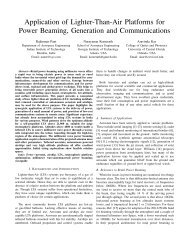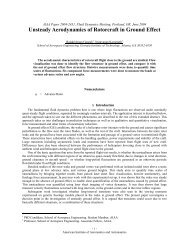Boeing-University Relations - A Review and Prospects for the Future
Boeing-University Relations - A Review and Prospects for the Future
Boeing-University Relations - A Review and Prospects for the Future
Create successful ePaper yourself
Turn your PDF publications into a flip-book with our unique Google optimized e-Paper software.
eport required is each Fellow’s individual plan <strong>for</strong> future ef<strong>for</strong>ts on his or her campus based onlessons learned during <strong>the</strong> entire Program.After ten years of operation, <strong>the</strong> Program has generally been considered a success in meeting its(limited) objectives. From its inception, it was hoped that programs similar in concept <strong>and</strong> intentto <strong>the</strong> WFSF would be emulated by o<strong>the</strong>r companies throughout <strong>the</strong> country as a significantmeans to encourage systemic change in engineering <strong>and</strong> related education programs of interest tous all. To date, however, <strong>the</strong> program remains unique to <strong>Boeing</strong> (notwithst<strong>and</strong>ing <strong>the</strong> existenceof industry-university research focused ef<strong>for</strong>ts like <strong>the</strong> NSF GOALI program), <strong>and</strong> now, after adecade of successful execution, has generated 107 alumni from about sixty colleges <strong>and</strong>universities (including HBUC/MIs <strong>and</strong> institutions of higher education in Australia <strong>and</strong> India).<strong>Boeing</strong> Fellow on Campus ProgramIn creating <strong>the</strong> WFSF, it was also recognized that its reciprocal could be of considerable value,<strong>and</strong> thus <strong>the</strong> concept of a <strong>Boeing</strong> Fellow on Campus Program was developed in parallel. Manyengineers <strong>and</strong> potential managers avail <strong>the</strong>mselves (often at company expense) of universitybasedcontinuing education opportunities as part of <strong>the</strong>ir career <strong>and</strong> professional development.Sending <strong>the</strong>m back to school as “adjunct” or “visiting” faculty, ra<strong>the</strong>r than as mere students,seemed a much more effective use of <strong>the</strong>ir talents <strong>and</strong> expertise – i.e. <strong>the</strong> “teacher” can oftenlearn much more than <strong>the</strong> students in <strong>the</strong> education process <strong>and</strong> every one (students, faculty, <strong>and</strong><strong>the</strong> industry individual) can thus gain from <strong>the</strong> campus experience provided by <strong>the</strong> extendedresidence of engineers from industry.A fur<strong>the</strong>r motivation <strong>for</strong> developing this program was <strong>the</strong> observation that <strong>the</strong>re was (<strong>and</strong>remains) as much ignorance of <strong>the</strong> realities of academe on <strong>the</strong> part of our industry colleagues aswe perceived <strong>the</strong>re to be on <strong>the</strong> part of faculty about industry. Thus, if sustained relations withacademe were to be established, a working knowledge of <strong>the</strong> constraints <strong>and</strong> dem<strong>and</strong>s on facultyseemed essential, <strong>and</strong> <strong>the</strong> best way to get it would to become resident “visiting instructor/students” <strong>for</strong> an extended (though limited) period of time – e.g. a minimum of an academicquarter or semester, depending on how a specific school was organized.With <strong>the</strong>se notions in mind, a program was constructed which identified suitable c<strong>and</strong>idates from<strong>Boeing</strong> to be fielded to willing schools in programs considered important to <strong>the</strong> company. Whathad not been adequately appreciated, however, is <strong>the</strong> ra<strong>the</strong>r brutal nature of <strong>the</strong> “industry rewardsystem”. While very different from <strong>the</strong> university “reward system”, individuals who embark on“extracurricular activities” like our proposed Fellow on Campus Program too often find that “outof sight, out of mind” <strong>for</strong> a period of more than a couple of weeks could have significantlyadverse career consequences. Despite careful work with both <strong>the</strong> schools <strong>and</strong> <strong>the</strong> managementchains <strong>for</strong> <strong>the</strong> initial trial c<strong>and</strong>idates <strong>for</strong> <strong>the</strong> program well be<strong>for</strong>e <strong>the</strong> actual assignment began in1996-97, <strong>the</strong> experience proved less than satisfactory <strong>for</strong> almost all involved. Thus, with <strong>the</strong>exception of a few more modest attempts to repeat <strong>the</strong> program at later times, it has not beencontinued. Work done with o<strong>the</strong>r companies on this type of project suggests that this situation iffar from unique to <strong>Boeing</strong>. The conclusion from this has been that <strong>the</strong> gap between academe <strong>and</strong>industry – at <strong>the</strong> working level – is even wider than had been thought, <strong>and</strong> that much of <strong>the</strong>problem lies on <strong>the</strong> industry side of <strong>the</strong> equation, ra<strong>the</strong>r than being due to academic recalcitrance.Proceedings of <strong>the</strong> 2005 American Society <strong>for</strong> Engineering Education Annual Conference & ExpositionCopyright ASEE 2005, American Society <strong>for</strong> Engineering Education.



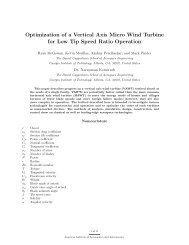
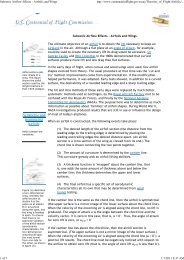

![p density of fluid, kg/m3 [Greek letter rho] V mean velocity of fluid, m ...](https://img.yumpu.com/50595898/1/184x260/p-density-of-fluid-kg-m3-greek-letter-rho-v-mean-velocity-of-fluid-m-.jpg?quality=85)
